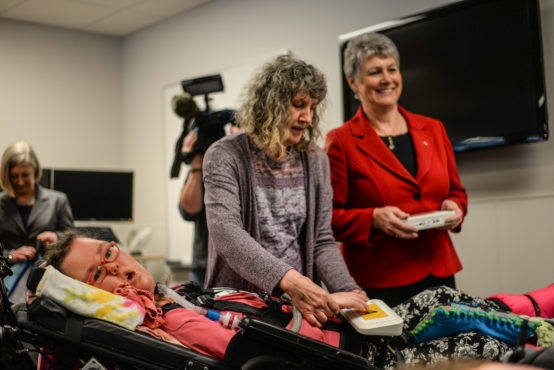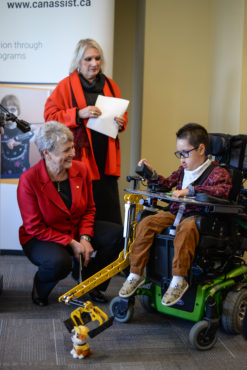Children with special needs now have the potential for a lot more independence, inclusion, and fun

All photos by Mike Graeme, Senior Staff Writer.
From robotic arms to pick up fallen toys to ball launchers that help children play catch with friends or fetch with dogs, UVic’s CanAssist organization has just released seven new technologies that will greatly increase opportunities for children with special needs across B.C.
“[These devices] enhance independence, participation, and inclusion for children with special needs, and they motivate children to achieve important developmental milestones, such as being able to use accessibility switches, to access needed devices, communicate choices, and improve their strength and dexterity,” said CanAssist Executive Director Robin Syme.
CanAssist began as a small venture at the University of Victoria and has since grown into an influential organization, helping improve the lives of thousands of individuals with disabilities and their families.

The current project is supported by B.C.’s Ministry of Children and Family Development, which contributed $1.5 million to the initiative in 2017.
All thirty-two Child Development Centres across rural and urban B.C. provided input during the project’s development and they will now each receive five of the new technologies by the end of November 2018.
“Our goal has been to make sure that the five core technologies would be delivered before December so that children across B.C. could enjoy them over the Christmas season,” Syme said.
“In all, almost 500 technologies will be delivered by the end of March. That’s a remarkable achievement for sure.”
CanAssist held a grand opening for their innovations at CARSA on Nov. 16. The public was invited for a tour and demonstration of the devices.
Minister of Children and Family Development Katrine Conroy was one among many excited observers gathered in the CanAssist centre.
“This project represents the first time that CanAssist has been able to provide the technologies in such the large numbers that Robin [Syme] was talking about,” Conroy said.
Conroy remembers a day when such high-end technology was not available for the children who needed it, and caregivers were left to make do with the tools they had at their disposal.
“I have to tell you in my past life I [was] an early childhood educator, and I remember going to conferences in the ’80s and we actually soldered together equipment so that we could take it back home to the kids we were providing services to,” she said, right before the tour of the technologies began.
“I’m just really looking forward to seeing how far technology has come because I don’t think any caregivers are soldering together devices anymore.”
Indeed, the technologies have come a long way from makeshift soldering projects.

One stop on the technology tour involved a mobile music therapy kit that integrates iPods and touchpads to allow children with different ranges of motion to participate in music composition.
The crowd watched as one child musician with an iPod strung around her wrist played a solo on an upright bass by swaying her arm back and forth.
Moving the iPod higher and lower allowed her to explore different notes of the musical scale, as Conroy picked up a touchpad and jammed along with a flute melody. The sensitivity settings can be adjusted to suit each child’s range of motion.
The music kit was introduced by Nathan Gartner, an electrical design technologist with CanAssist who helped design the music-making system.
Music was a big part of Gartner’s childhood, and he expressed his excitement to be sharing that passion.
“I started playing music when I was fourteen and then music led me to sound and audio, and then audio led me to electronics … and then [I] found a way to blend those passions with helping people,” he said.
Gartner acknowledged the importance of music therapy but said it’s not always accessible.
“Some kids don’t always have a music therapist with them,” he said, adding that the music therapy kit can be used by anyone with access to an app store.
Conroy said that these soon-to-be widely available technologies are so important for children with diverse abilities not only because they are exciting new toys to play with, but also because they increase the children’s ability to interact with their peers.
“Kids can see how collaboration and creativity aided by technology results in their inclusion and their ability to do so much more,” she said. “And when every level of ability and participation is recognized as important, that is the seed that leads … to some pretty amazing accomplishments.”

The music kit wasn’t the only technology that helps children participate with others.
Other technologies showcased at the event included a remote-control car with a modified control stick that can be used by children whose levels of dexterity prevent them from operating commercial ones.
This technology is already allowing some children in Williams Lake to be a part of the local Remote-Control Car Club, said Syme.
“They’re going to integrate their car into the community and have the children actually participate in the club in a way they haven’t been able to before, so that’s pretty exciting as well,” Syme said.
Many of us take our physical independence and social integration for granted — others don’t have that liberty. CanAssist’s new technologies are paving the way for children with disabilities to experience inclusion, self-reliance, and fun in ways they may never have before.








